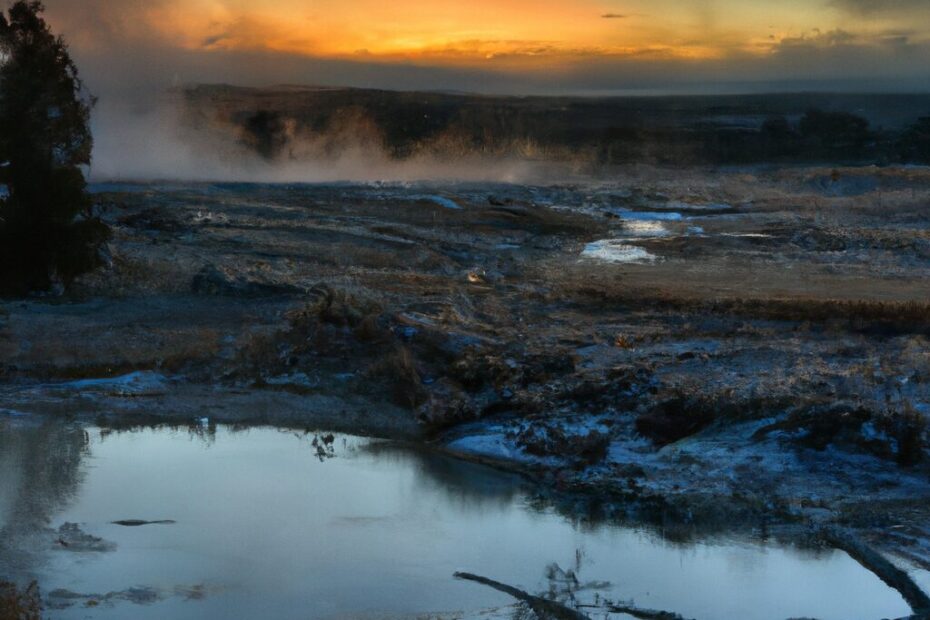Yellowstone National Park is famous for its stunning thermal features, including the mesmerizing Plume Geysers. In this comprehensive guide, we will explore everything you need to know about these unique natural wonders.
From understanding how Plume Geysers differ from other geysers to discovering their formation process and eruption patterns, we will cover it all. Join us as we delve into the characteristics, best viewing times, and safety precautions for experiencing the magic of Plume Geysers in Yellowstone National Park.
What are Thermal Features in Yellowstone National Park?
Yellowstone National Park is renowned for its spectacular thermal features, characterized by geothermal phenomena resulting from volcanic activity. These contribute to the park’s unique natural wonders and geological formations.
The thermal features found in Yellowstone National Park, including geysers, hot springs, mud pots, and fumaroles, have a significant impact on the park’s geology and diverse ecosystems. These geothermal formations not only create a dynamic landscape that draws visitors from all over the world, but they also serve as valuable educational resources for understanding Earth’s geothermal processes.
Moreover, these thermal areas are vital habitats for a wide range of wildlife, highlighting the interconnectedness of geothermal energy and ecological sustainability within the park.
What is a Plume Geyser?
A Plume Geyser is a hydrothermal feature found in geothermal areas such as Yellowstone National Park, characterized by its periodic eruption of hot water and steam, often originating from a thermal pool fueled by underground geothermal energy.
These impressive geysers are known for their striking plumes of steam and water that can reach considerable heights, drawing inquisitive visitors from around the world.
The heat source that powers these geysers is the superheated water trapped below the Earth’s surface, which periodically erupts upwards, creating the awe-inspiring displays that capture the imagination.
Plume Geysers play a crucial role in forming thermal pools, adding to the otherworldly beauty of their surroundings, while also serving as significant indicators of the geothermal energy potential of the region.
How is a Plume Geyser Different from Other Geysers?
Plume Geysers stand out from other geysers due to their distinct eruption patterns and the geological processes that drive their unique manifestations within geothermal systems.
Plume Geysers are known for their powerful bursts of water and steam, shooting high into the air and forming impressive plumes. These eruptions are caused by the interaction of groundwater and superheated rocks deep within the Earth’s crust, resulting in a build-up of pressure and a dramatic release. This makes them distinct from other hydrothermal features like fumaroles and hot springs, making Plume Geysers a captivating and dynamic part of geothermal landscapes.
Where Can You Find Plume Geysers in Yellowstone National Park?
Plume Geysers are prominently located within Yellowstone National Park, and visitors can explore these geothermal marvels with the assistance of informative geology guides, delving into the geological features and the natural history of the area.
These captivating Plume Geysers can be found in various locations throughout Yellowstone National Park, including the Upper Geyser Basin, known for its high concentration of active geysers.
The Norris Geyser Basin offers a unique opportunity to witness the geothermal activity amidst a diverse array of thermal features. The informative geology guides not only aid in understanding the geological significance but also highlight the ecosystem management efforts to preserve these natural wonders, emphasizing the delicate balance between tourism and conservation.
What is the Most Famous Plume Geyser in Yellowstone?
The most famous Plume Geyser in Yellowstone captivates visitors with its remarkable eruptions and serves as a prominent tourist attraction, showcasing the ecological significance and geological wonders fueled by the park’s rich geothermal resources.
Visitors are often awestruck by the geyser’s eruptions, shooting hot water and steam high into the air, creating a mesmerizing display of natural power.
Its location within the park underscores the diverse landscape and the area’s remarkable geothermal activity, adding to the allure of experiencing the park’s ecological diversity. Plume Geyser is an essential reminder of the importance of preserving and protecting these valuable natural resources for future generations to appreciate and study.
How Do Plume Geysers Form?
The formation of Plume Geysers is intricately tied to the park’s volcanic landscape and the ongoing environmental protection efforts that support sustainable tourism. This is shaped by complex geological processes within the geothermal systems.
The geysers in this park are a result of the volcanic activity, with their distinctive shapes developing over hundreds of years. This is due to a combination of underground pressure, heat, and groundwater circulation.
The interaction between superheated water and minerals deep within the Earth’s crust creates the perfect conditions for these geysers to erupt, releasing powerful plumes of steam and hot water. Preserving the park’s geothermal systems is crucial in maintaining the delicate balance necessary for the survival of Plume Geysers, emphasizing the significance of environmental conservation for sustainable tourism in the region.
What Causes a Plume Geyser to Erupt?
The eruption of a Plume Geyser is triggered by specific hydrothermal mechanisms and geological features influenced by the intricate workings of the park’s geothermal systems, prompting scientific research into their eruptive behaviors.
Hydrothermal mechanisms involve the interaction of heated water with underground rocks, creating a build-up of pressure that eventually leads to the geyser’s eruption.
Geological features such as underground reservoirs and fractures in the earth’s crust also play a crucial role in regulating the timing and intensity of these eruptions. The geothermal systems within the park contribute to the unique conditions necessary for Plume Geysers to erupt, making them subjects of ongoing scientific study to unravel the complex interplay of factors governing their behavior.
What is the Eruption Pattern of a Plume Geyser?
The eruption pattern of a Plume Geyser showcases a rhythmic display of geothermal activity, contributing to the park’s environmental stewardship and the meticulous management of volcanic eruptions within the area.
This unique eruption pattern is not only a sight to behold but also serves as a critical indicator of the geothermal activity beneath the surface.
Through careful monitoring and scientific understanding, park management can anticipate and respond to any potential changes in the geyser’s behavior, ensuring the safety of both visitors and the surrounding ecosystem.
By studying these natural phenomena, researchers can gain valuable insights into volcanic activity, ultimately contributing to improved hazard mitigation and environmental conservation efforts in the park.
What Are the Characteristics of a Plume Geyser?
The characteristics of a Plume Geyser encompass its temperature, eruption height, and the mesmerizing spectacle of its geothermal manifestations, offering valuable insights for geothermal education and contributing to the park’s geological wonders.
These geysers are renowned for their soaring eruption heights, often reaching over 30 feet, propelled by the intense heat from the Earth’s molten core.
The water within these geysers can exceed boiling temperatures, creating a captivating display of steam and bubbling water. The unique combination of heat and water creates an otherworldly atmosphere that captures the imagination of visitors and reinforces the significance of geothermal energy within the park’s natural landscape.
What is the Temperature of a Plume Geyser?
The temperature of a Plume Geyser reflects the intense geothermal energy at work, shaping the park’s geological features and contributing to the preservation of natural resources within the area.
Did you know that the Plume Geyser’s high temperature is caused by underground hot water reservoirs and magma chambers? This intense heat not only powers the geyser’s eruptions, but it also plays a key role in shaping the park’s distinctive geological formations.
The geothermal energy not only creates hot springs and terraces, but it also helps preserve the park’s natural resources. This unique influence on the landscape makes for a fascinating and diverse environment.
What is the Height of a Plume Geyser’s Eruption?
The height of a Plume Geyser’s eruption contributes to the park’s geological wonders and serves as a catalyst for environmental awareness related to the significance of geothermal systems in shaping these mesmerizing displays.
When you witness a Plume Geyser erupting, reaching impressive heights that can surpass 100 feet, it becomes an awe-inspiring reminder of the power and beauty of nature.
This phenomenon highlights the intricate interplay between the Earth’s geothermal activity and the creation of these captivating displays, making it a living testament to the park’s unique geological features. By drawing attention to the impact of geothermal systems, it fosters a deeper understanding of the environmental factors at play in these natural spectacles, contributing to a greater appreciation for the delicate balance of our planet’s ecosystems.
How Often Does a Plume Geyser Erupt?
The frequency of a Plume Geyser’s eruptions holds ecological significance and informs ecosystem management efforts aimed at preserving the park’s unique geological features and hydrothermal phenomena.
These eruptions play a crucial role in shaping the local ecosystem by creating unique hydrothermal habitats that support specialized microbial communities and thermophilic organisms.
The periodic release of mineral-rich water during eruptions contributes to the park’s nutrient cycles, influencing the growth of vegetation in the surrounding area.
Understanding the eruption frequency of Plume Geysers is essential for implementing effective conservation strategies to safeguard the biodiversity and ecological balance of the park’s diverse landscape.
What is the Best Time to See a Plume Geyser Eruption?
The best time to witness a Plume Geyser eruption offers visitors a remarkable and immersive experience, intertwining with the park’s volcanic landscape and providing opportunities for memorable outdoor recreation.
During the late morning or early afternoon, when the sunlight illuminates the geyser’s plume in a breathtaking display, is an ideal time for optimal observation.
This natural spectacle, set against the geothermal features of the park, creates a captivating juxtaposition of power and serenity.
Visitors can also take advantage of this experience by incorporating hiking or picnicking in the surrounding areas, allowing them to fully immerse themselves in the enriching environment and take advantage of the recreational opportunities available.
What Precautions Should You Take When Visiting a Plume Geyser?
When visiting a Plume Geyser, it is essential to adhere to precautionary measures to ensure visitor safety, minimize environmental impact, and support the park’s conservation and environmental protection efforts under the guidance of park management.
This includes staying on designated trails and boardwalks to protect the delicate ecosystem surrounding the geyser. It’s important to refrain from littering or disturbing wildlife, and follow all posted regulations.
Additionally, it’s crucial to respect the natural beauty of the area by not removing any rocks or artifacts. By following these guidelines, visitors can actively contribute to the preservation of the park’s natural resources and help ensure that future generations can enjoy the geyser and its surrounding environment.
What Other Thermal Features Can You See Near Plume Geysers?
Exploring the area near Plume Geysers offers opportunities to discover diverse thermal features, contributing to geothermal exploration, ecosystem conservation efforts, and the observation of ecological diversity fueled by the region’s abundant geothermal resources.
The thermal features in this region, such as hot springs, fumaroles, and thermal pools, are essential in displaying the ever-changing nature of geothermal activity. The presence of geysers also aids in geothermal exploration, offering valuable information about the underground thermal systems.
Aside from their scientific significance, these thermal features also play a crucial role in conservation efforts. They support unique ecosystems that thrive in the vicinity of these geothermal resources. Visitors can witness the diverse ecological life sustained by the region’s geothermal resources, showcasing the interconnectedness of geothermal energy and the natural environment.
Frequently Asked Questions
What is a Plume Geyser thermal feature?
A Plume Geyser thermal feature is a hydrothermal formation that creates a column of hot water and steam that erupts from the ground.
Where can I find Plume Geyser thermal features?
Plume Geyser thermal features can be found in geothermal areas, such as Yellowstone National Park, where there are high concentrations of geysers and hot springs.
How do Plume Geyser thermal features form?
Plume Geyser thermal features form when groundwater is heated by magma or hot rocks deep underground. The heated water then rises to the surface, creating the geyser’s iconic eruption.
Are Plume Geyser thermal features dangerous?
While Plume Geyser thermal features can be mesmerizing to watch, they can also be dangerous. The water and steam can reach extreme temperatures and the ground around them can be unstable, so it is important to always stay on designated trails and follow park safety guidelines.
Can I visit Plume Geyser thermal features year-round?
It is possible to visit Plume Geyser thermal features year-round, but some may have different eruption patterns or may be completely frozen over during the winter months. It is best to check with park rangers for current geyser activity and accessibility.
Is there any wildlife that can be found near Plume Geyser thermal features?
Yes, Plume Geyser thermal features provide a unique habitat for certain types of bacteria and microorganisms, which can attract birds and other animals to the area. Visitors should always respect the natural environment and observe wildlife from a safe distance.
Last Updated on January 26, 2024 by Jon Waraas – Originally Posted: January 25, 2024

I’m Jon Waraas, and I’ve been navigating the online world since 2006. By day, I’m the proud owner of some eCommerce gems, and by night, I’m the voice behind the adventures on Waraas.Com.
My heart, however, belongs to the wild beauty of Yellowstone National Park. I’ve got a collection of websites dedicated to sharing the wonders of this natural masterpiece. Oh, and did I mention? I’m currently building my own cabin inside the ghost town of Gilmore, Idaho – a cabin with tales to tell!
When I’m not immersed in the digital realm, you’ll find me lacing up my boots for a good hike or setting up camp under the star-studded sky.




